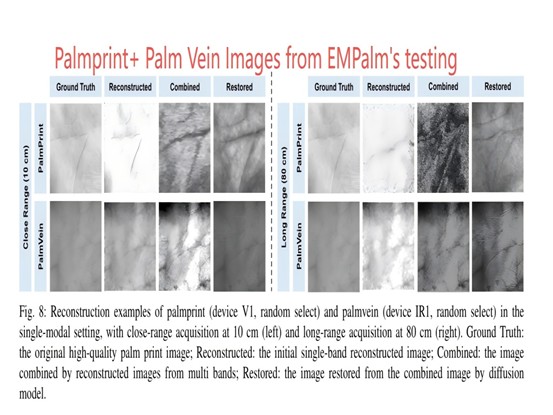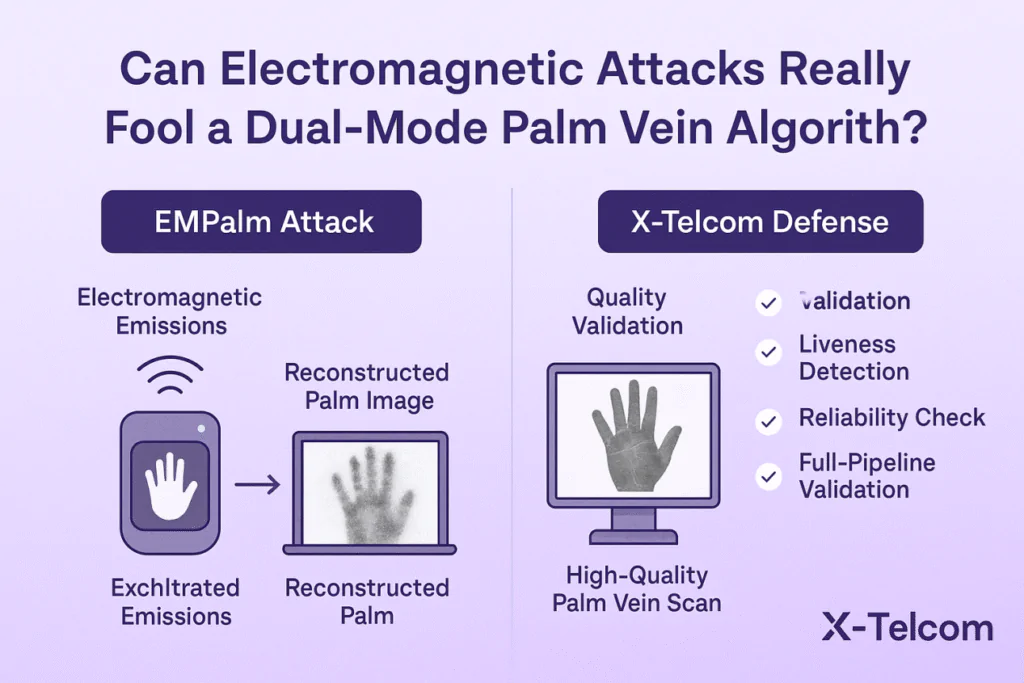Understanding the EMPalm Research
A recent academic study titled “EMPalm: Exfiltrating Palm Biometric Data via Electromagnetic Side-Channels” explored the possibility of using electromagnetic (EM) emissions to reconstruct palm or palm-vein images from biometric devices.
The research simulated attacks that monitored EM signals during image acquisition or transmission to recover biometric data, achieving a moderate similarity score (SSIM ≈ 0.79).

While such findings highlight a theoretical risk, they do not reflect real-world attack feasibility in commercial-grade systems.
In fact, the reconstructed images are typically noisy, distorted, and lack the vein depth and contrast necessary for recognition within any professional Palm Vein system.
X-Telcom’s Dual-Mode Palm Vein Technology: Built for Security
At X-Telcom, we design every generation of our Palm Vein Technology to withstand not only spoofing and replay attempts, but also emerging threats from side-channel analysis.
Our algorithm and SDK framework integrate multi-layer protection and validation to ensure that no synthetic or reconstructed image can pass the verification pipeline.
🔐 1. Quality Validation Layer
Every palm image—whether infrared or RGB—is validated in real time using our internal ScoreKey system.
Low-contrast, blurred, or noisy frames automatically fail the kPalmQualityOperator threshold (≥ 0.5), ensuring that only high-integrity data enters the matching process.
🧠 2. Liveness Detection: Multi-Modal Fusion
Our Dual-Mode Palm Vein Algorithm fuses IR + RGB channels for genuine liveness confirmation.
Three independent checks work simultaneously:
- IR Liveness Detection (
kPalmLivenessOperator ≥ 0.5) - RGB Liveness Detection (
kPalmLivenessColorGrayOperator ≥ 0.5) - Dual-Mode Fusion Liveness (
BiModal ≥ 0.85for high-security use)
This tri-layer liveness verification guarantees that photos, printouts, or screen replays cannot be mistaken for real human palms.
⚙️ 3. Reliability and Motion Detection
Unstable or manipulated signals—such as those from EM reconstruction—show irregular pixel patterns and inconsistent frame motion.
These are automatically rejected through our kPalmReliabilityIr/RgbOperator and motion-perception modules before any features are extracted.
🔁 4. Full-Pipeline Validation
Even if a single check fails, the SDK returns an immediate error rather than partial results.
Only when all parameters meet secure thresholds (result = kDimPalmSuccess) does the system proceed to feature extraction and matching—closing the door on false acceptance.
Beyond Algorithm Security: Hardware and EMI Design
X-Telcom complements algorithmic defense with hardware-level security design:
- EMI-shielded PCB and transmission interfaces
- Encrypted data channels between palm module and processor
- Optional random frame sequence (“challenge–response”) capture for anti-replay verification
Together, these create a software + hardware security ecosystem that prevents any leakage of usable biometric data.
The Real-World Result
Academic research like EMPalm helps drive innovation and strengthen security standards.
But in practice, X-Telcom’s Dual-Mode Palm Vein Technology ensures that such side-channel reconstructions cannot bypass our algorithmic gates nor produce valid biometric matches.
For governments, banks, fintech integrators, and healthcare platforms deploying our Palm Vein systems, this means:
✅ Certified EMV/PCI-grade hardware
✅ Real-time quality + liveness control
✅ Dual-channel RGB + IR verification
✅ Complete SDK/API with anti-spoofing intelligence
Only authentic, live human palms are accepted — nothing else.
Conclusion
Electromagnetic side-channel attacks remain an important area of academic research, but they do not compromise X-Telcom’s production-grade Palm Vein systems.
Our commitment to algorithm transparency, hardware integrity, and biometric safety keeps every user’s data secure — beyond surface, beyond imitation.
Learn More: Palm Vein Reader



